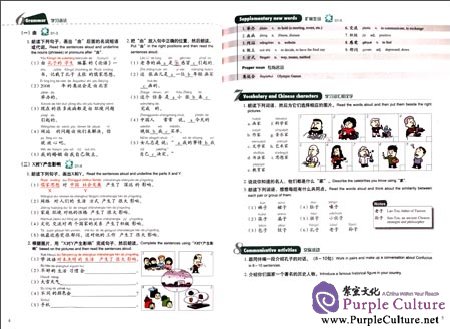Details
Usage Advice: Classroom teaching: 1 hour in class and 0.5-1 hour outside class for each lesson; Self-study: 1-1.5 hours per lesson
Level: Elementary
New Concept Chinese, a series of Chinese textbooks for adults, is suitable for both self-teaching and classroom teaching. Observing the principle of “making Chinese easier to learn”, this series presents practical, concise and interesting teaching materials and employs easy, flexible and effective teaching methods so that students and teachers could learn and teach Chinese in a convenient and effective way.
The whole series includes Textbooks, Workbooks, Chinese Character Workbooks, Teacher’s Books, Flashcards and CD-ROMs.
This is Textbook 4 in the series, suitable for adults who have finished studying New Concept Chinese (1-3) or have attained the equivalent Chinese proficiency. It has a total of 20 units, each with one lesson. It teaches about 600 common Chinese words, over 200 Chinese characters and 40 grammar points, encompassing topics that foreigners are mostly likely to encounter in their study, daily life and work. Having finished this volume, students’ Chinese proficiency will reach a level equivalent to Level 4 of the New HSK.
About the Author
Mr. Cui Yonghua is a researcher in Beijing Language and Culture University. He has been engaged in the field of Chinese teaching and research since 1981. His research focuses on Chinese grammar, Chinese language teaching and Chinese information processing, and his publications include Classroom Techniques for Teaching Chinese as a Foreign Language, Teaching and Research of Chinese as a Foreign Language (a collection of academic papers) and some textbooks coauthored with others, such as Standard Chinese Course, Learning Chinese and Learn Chinese through Listening, Speaking and Watching. Mr. Cui has chaired and participate in many research projects, such as Radical Standards of GB13000.1Character Set for the Purpose of Information Processing, and has written a number of academic papers, the representative ones being “Syntactic and Semantic Issues Related to Commendatory and Derogatory Adjectives”, “An Attempt in Analyzing the Sentence Pattern ‘连……也……’” and “About the Methodology of TCFL as a Discipline”, etc.
Sample Pages Preview

(二)X对Y产生影响
1.朗读下列句子,画出x和Y。
(1)儒家思想对中国社会发展产生了深远的影响。
(2)网络对人们的生活方式产生了很大影响。
(3)家庭环境对他的性格产生了很大影响。
(4)文化交流对两个国家的关系产生了积极影响。
(5)他最近感觉很郁闷,这对他的工作产生了很大影响。
